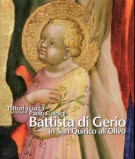Fra Angelico
| Autore/i | Renzo Villa | ||
| Editore | Pacini Editore - Menarini | Luogo | Pisa |
| Anno | 2018 | Pagine | 272 |
| Dimensioni | 24x33 (cm) | Illustrazioni | 150 ill. colori n.t. - colors ills |
| Legatura | cart. edit. con sovracc. ill. colori - Hardcover with dustjacket | Conservazione | Nuovo - New |
| Lingua | Inglese - English text | Peso | 2500 (gr) |
| ISBN | N/D - N/A | EAN-13 | N/D - N/A |
momentaneamente non disponibile
(Collezione d'Arte A. Menarini).
Special edition published by Pacini Editore for A. Menarini Industrie Farmaceutiche Riunite
The fate of the artist known to all as 'Beato Angelico', an enchanting protagonist of Italian painting, is exceptional or unique from every point of view. Master of sacred art, but also interpreter of the early humanistic Renaissance; author of exemplary, lyrical and emotional images of Madonnas, Angels and Saints, but also capable of decisive technical innovations, from the square format of the large tables on the altars unifying the political precedents, to the model of the 'Sacred Conversation' where the saints converse naturally and spiritually in the presence of the Mother and the Son.
His is a multifaceted and varied, highly personal work; however never signed or dated, giving great problems to art historians. Humble and discreet he would have been disconcerted by the nickname "Beato Angelico", who simply wanted to be Fra Giovanni of the convent of San Domenico in Fiesole. Also known, as a young lay person, as Guido di Piero del Mugello.
Angelico was said to have just passed away, for the high praise addressed to the Master, to the architect of grandiose tabernacles, reliquaries and decorated altarpieces, of varied and inimitable cycles of frescoes, of many illuminated pages where he always expressed his faith, enhancing beauty of the spiritual creatures in the pure faces of the Madonnas and in the sparkling wings of the celestial creatures. Angelic for grace and gentleness of tones and colors, and for always intense and participatory inspiration. Recognized by his contemporaries as supreme master, he accompanied the overcoming of the last Gothic by proposing a new reading of the ancient, and was nominated Blessed to be an exemplary artist model, recognized Patron of sacred art by the Catholic Church.
Despite this, the fate of his pictorial work, the result of forty years of continuous, active and highly esteemed work, was marked by the dispersion of many creations, also marred by neglect and unfortunate restorations. Fragmented and uprooted from their original location, they are quieter, less expressive and exciting, and yet exhibited in every respect in the major museums of Europe and America. They have a very different fate from the one expected and foreseen since they had been carried out at the request and compensation of the largest Florentine families, and were intended for the liturgy, for the contemplation and veneration of the faithful.
Unfortunately, only one in five of the great pictorial cycles created in Rome came to us, where two popes had called him recognizing him as "the first painter of Italy". Four were destroyed not even a century after their completion, in an anxious era of more grandiose modernity; Fortunately for us, the Niccolina Chapel in the Vatican remains intact, one of the most balanced and measured cycles of the entire Italian fifteenth century, in its renewed early Christian classicism. Finally, exceptionally and fortunately intact, it is the most personal and heartfelt work, now visible to anyone, admirable in its completeness and conservation. It is the series of frescoes of the Florentine convent of San Marco, paradoxically destined to remain secret, bound by the cloister, painted only for the meditation and prayer of a single confrere in his solitary cell.
(T-CA)
Potrebbero interessarti anche...





